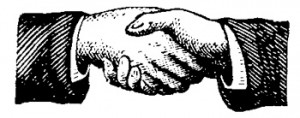From NPR’s Marketplace News – Researchers from the University of Manchester have distilled the components of a perfect handshake down to a science, literally, and it looks like:
PH = √(e2 + ve2)(d2) + (cg + dr)2 + p{(4< s >2)(4< p >2)}2 + (vi + t + te)2 + {(4< c >2 )(4< du >2)}2
The values are on a 1-5 scale:
(e): eye contact (1=none; 5=direct) — 5
(ve): verbal greeting (1=totally inappropriate; 5=totally appropriate) — 5
(d): Duchenne smile — smiling in eyes and mouth, plus symmetry on both sides of face, and slower offset (1=totally non-Duchenne smile (false smile); 5=totally Duchenne) — 5
(cg): completeness of grip (1=very incomplete; 5=full) — 5
(dr): dryness of hand (1=damp; 5=dry) — 4
(s): strength (1= weak; 5=strong) — 3
(p): position of hand(1=back towards own body; 5=other person’s bodily zone) — 3
(vi): vigor (1=too low/too high; 5=mid) — 3
(t): temperature of hands (1=too cold/too hot; 5=mid) — 3
(te): texture of hands (1=too rough/too smooth; 5=mid) — 3
(c): control (1=low; 5=high) — 3
(du): duration (1= brief; 5=long) — 3
I wonder if there is a way to add a component for a proper Masonic Handshake?
Read: The Masonic Handshake

